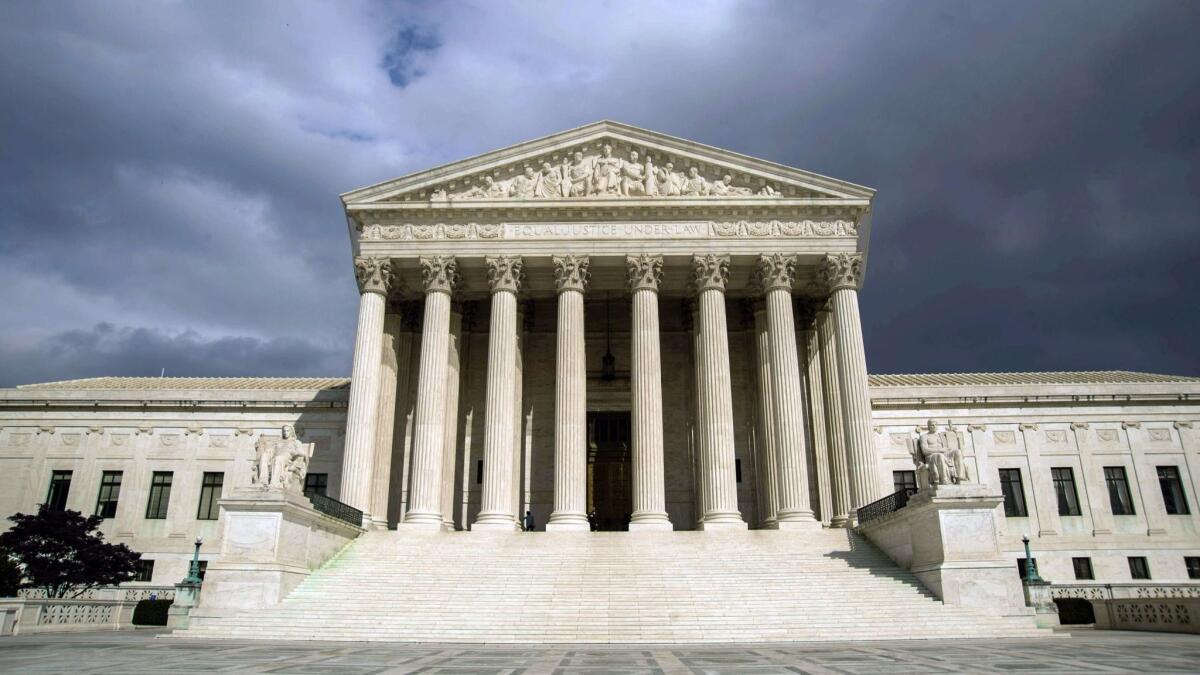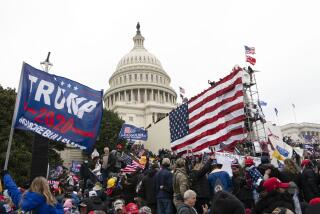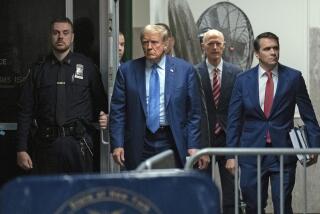Supreme Court puts off a final decision on Trump’s new travel ban

Reporting from WASHINGTON — The Supreme Court’s decision Monday to postpone arguments over the legality of President Trump’s travel ban is likely to send the controversy back to lower courts to consider his revised order, released Sunday.
The court canceled arguments that had been scheduled for Oct. 10 to consider whether Trump’s travel ban is a valid measure to protect against terrorism or an unconstitutional scheme to ban Muslims from coming to the country.
But the legal dispute is almost certain to come back to the high court for a final decision, perhaps in a matter of weeks.
Trump’s lawyers have suffered a series of defeats before federal judges in Hawaii and Maryland and before U.S. appeals courts in Virginia and California. They remained confident they had a good chance of winning in the Supreme Court.
In late June, the justices set aside rulings by the lower courts that had blocked Trump’s temporary travel ban, allowing parts of it to take effect.
At the same time, the justices agreed to hear arguments from the administration’s lawyers who said the president has “broad authority to prevent aliens from entering this country if he deems it to be in the nation’s interest.”
But a key part of the temporary travel ban — which restricted nationals from six mostly Muslim countries — expired on Sunday.
In its place, the president issued a 28-page proclamation setting forth a revised and expanded entry ban that affects seven nations, including now Chad and North Korea. Sudan was dropped for the previous list, which included Iran, Libya, Somalia, Syria and Yemen.
And unlike the earlier versions, the new restrictions will extend indefinitely.
The new ban in effect rendered the pending cases moot. In a brief order, the justices asked the lawyers on both sides to submit letters by Oct. 5 on what should be done next. And they added, “The cases are removed from the oral argument calendar, pending further order of the court.”
Still unresolved is the part of the temporary order that blocked refugees from the six originally targeted nations. That part of the order expires in late October, and the administration may wait until then to say what comes next.
Meanwhile, the law that governs admission of refugees says that the president is supposed to set annual levels by Oct. 1 of each year. Advocates for refugees fear that Trump will keep the level at 50,000, the temporary cap he put in the earlier version of the travel ban — or even make it lower. Obama had set a goal at 110,000 refugees.
“I think what he was trying to do is lay the groundwork to substantially lower the number of refugees who are welcomed into the U.S.,” said Cathryn Miller-Wilson, executive director of the Pennsylvania branch of HIAS, a refugee resettlement agency, adding that advocates will be making their case to Congress this week.
In the case of refugees fleeing violent governments, it’s unlikely that the governments would cooperate in sharing information about them, she said. And she said it often takes years for refugees to win approval to enter the U.S.
“They’re desperate and they’re survivors, and now we’re going to be slamming the door in their faces,” she said.
Experts in immigration law were divided over whether Trump’s revised order stands a better chance of being upheld. Some said the new order stands on stronger ground because it reflects a careful review of the vetting procedures in the affected countries.
“Restrictions were tailored, as appropriate, given the unique conditions and deficiencies in each country,” the White House said. The new order exempts current visa holders and immigrants who are lawful permanent residents in this country.
But others said the new restrictions are more vulnerable to legal challenge because they are permanent. This “undermines the structure and purpose” of the federal immigration law, said Peter Margulies, a law professor at Roger Williams Law School in Rhode Island.
The legal dispute may focus again on two seemingly conflicting parts of the law. One provision, cited regularly by Trump’s lawyers, says the president has the power to “suspend the entry of all aliens or any class of aliens” as he deems appropriate. But another provision, cited by the challengers, says immigrants may not be denied entry because of their nation of origin.
In justifying this third version of the travel restrictions, the administration took pains to describe their efforts to analyze the security situation in countries around the world — even though the list of countries with restrictions stayed mostly the same. Some legal experts say that might help Trump defend his ban from what will almost certainly be another set of legal attacks.
But lawyers opposing the ban can point to Trump’s rhetoric from last year, calling for a ban on Muslims entering the United States, said Faiza Patel, co-director of the Liberty and National Security Program at the Brennan Center for Justice.
“When you start with an illegal attempt and whittle away at it to present something that doesn’t look as bad as the first iteration, your original sin in a sense carries forward with you,” she said.
“Country here is just a proxy for religion,” she said. “Trump came in and campaigned on an absolute myth that we don’t know who’s coming into the country, that we don’t actually vet them, which couldn’t be further from the truth,” she said. “In fact the U.S. has one of the strictest visa vetting regimes in the world.”
On Twitter: DavidGSavage
UPDATES:
2:45 p.m.: This article was updated with more information about the new ban and reaction.
This article was originally published at 11:05 a.m.
More to Read
Get the L.A. Times Politics newsletter
Deeply reported insights into legislation, politics and policy from Sacramento, Washington and beyond. In your inbox three times per week.
You may occasionally receive promotional content from the Los Angeles Times.












